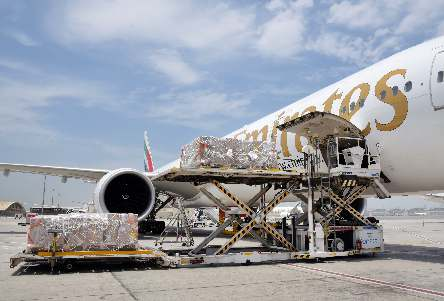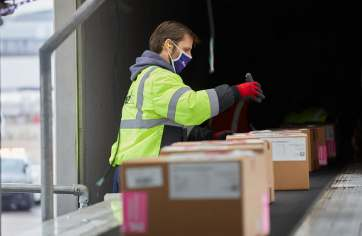Rosy outlook for air cargo industry as world battles pandemic
The pandemic has shattered so many lives and economies. And its longer-term effects for people and businesses, for better or worse, are irrevocable, leaving us with no option but to adopt to our new normal and the evolving challenges.
 When the Coronavirus spread worldwide, the global air cargo industry became the lifeline of humanity, transporting vital medical supplies and other essentials to save lives while the many people behind their operations are risking their own. Its role continued this year with the additional responsibility of flying billions of COVID-19 vaccines across continents which the International Air Transport Authority (IATA) dubbed as the “mission of the century.”
When the Coronavirus spread worldwide, the global air cargo industry became the lifeline of humanity, transporting vital medical supplies and other essentials to save lives while the many people behind their operations are risking their own. Its role continued this year with the additional responsibility of flying billions of COVID-19 vaccines across continents which the International Air Transport Authority (IATA) dubbed as the “mission of the century.”
So far, more than 4.54 billion doses have been administered globally with about 30.4% of the world population receiving at least one dose of COVID-19 vaccine, according to various reports. By the end of this year, more than 11 billion doses would have been manufactured.
COVAX or the COVID-19 Vaccines Global Access, a worldwide initiative aimed at providing for an equitable access to COVID-19 vaccines directed by GAVI, the Vaccine Alliance, the Coalition for Epidemic Preparedness Innovations, and the World Health Organization, has delivered more than 188 million doses to 138 countries to date.
 By early 2022, COVAX hopes to distribute 2 billion doses to poor income nations, funded by G7 countries and other donors. Their efforts, however, remain heavily challenged due to financial constraints, poor health infrastructure and systems as well as the emergence of new COVID variants disrupting global recovery.
By early 2022, COVAX hopes to distribute 2 billion doses to poor income nations, funded by G7 countries and other donors. Their efforts, however, remain heavily challenged due to financial constraints, poor health infrastructure and systems as well as the emergence of new COVID variants disrupting global recovery.
CARGO MILESTONES
The global air cargo industry ended 2020 with $128.2 billion in revenues, a new all-time high, amid a surge on rates resulting from limited cargo capacity, even as there remains, on the other hand, a high demand for air cargo goods and e-commerce shipments.
 “As a result, air freight rates were 55.9% higher in 2020 overall compared to 2019, at 2.79$/kg. Combined with the relatively resilient outcome in air cargo volumes (down 9.1% year-on-year in 2020), this means revenues from transporting goods by air rose by 27.2% in 2020. At $128.2bn, this is a new all-time high. This far offsets the fall in passenger traffic, but still provides needed support to airlines that were able to operate cargo flights,” IATA pointed out in its newly-released World Air Transport Statistics 2021 (WATS).
“As a result, air freight rates were 55.9% higher in 2020 overall compared to 2019, at 2.79$/kg. Combined with the relatively resilient outcome in air cargo volumes (down 9.1% year-on-year in 2020), this means revenues from transporting goods by air rose by 27.2% in 2020. At $128.2bn, this is a new all-time high. This far offsets the fall in passenger traffic, but still provides needed support to airlines that were able to operate cargo flights,” IATA pointed out in its newly-released World Air Transport Statistics 2021 (WATS).
Many airlines whose passenger planes remain grounded due to the pandemic and travel ban opted to convert some aircraft to freighter use yet their combined capacity were still not enough to meet the surge on air cargo demand.
 “The lack of available passenger aircraft meant that air cargo capacity was not sufficient to accommodate the rapid rebound in demand. Indeed, despite airlines increasing freighters capacity and converting passenger aircraft to freighters, industry-wide available cargo ton-kilometers (ACTKs) fell 21.2% year-on-year in 2020. This led to a capacity crunch, with the industry-wide cargo load factor up 7.1 percentage points to 53.9%. This is the highest value in the IATA series started in 1990,” WATS said.
“The lack of available passenger aircraft meant that air cargo capacity was not sufficient to accommodate the rapid rebound in demand. Indeed, despite airlines increasing freighters capacity and converting passenger aircraft to freighters, industry-wide available cargo ton-kilometers (ACTKs) fell 21.2% year-on-year in 2020. This led to a capacity crunch, with the industry-wide cargo load factor up 7.1 percentage points to 53.9%. This is the highest value in the IATA series started in 1990,” WATS said.
By end-2020, industry-wide cargo ton-kilometers (CTKs) had returned close to pre-crisis values, IATA said. But noted that the yearly decline in cargo demand (CTKs) was still the largest since the Global Financial Crisis in 2009, at a sizeable 9.7% year-on-year in 2020.
The high demand for air cargo services is carried through 2021 with the first half of the year seeing 8% growth, the industry’s strongest half performance in four years.
“Air cargo is doing brisk business as the global economy continues its recovery from the COVID-19 crisis. With first-half demand 8% above pre-crisis levels, air cargo is a revenue lifeline for many airlines as they struggle with border closures that continue to devastate the international passenger business. Importantly, the strong first-half performance looks set to continue,” Willie Walsh, IATA’s Director General, said in a statement.
Cargo business has indeed created opportunities for many struggling airlines, some accounting for as much as 49% of their revenues in 2020.
In 2019, cargo carriers faced declining volumes amid the US and China trade war, resulting to low production and demand among major exporters and importers of various products.
But a reversal of fortune occurred in 2020 with demand for air transportation shooting up at an all-time high to carry disposable face masks, oxygen cylinders, ventilators, personal protective equipment (PPE), among many other medical supplies and equipment needed at hospitals worldwide to treat millions of people infected with the virus.
Masks alone account for a huge proportion of the cargo hauled in 2020 estimated at nearly 2 billion. According to studies, the global market for disposable masks grew exponentially to 396.6% in 2020 and this year to 18.2%. The market and intelligence firm, Research and Markets, estimate the mask industry to reach US$28.8 billion in value by 2027.
The pandemic kept many cargo airlines busy throughout 2020. Topping the list measured in terms of scheduled cargo-ton kilometers were two American-based cargo and logistics firms – Federal Express (19.7 billion CTKs) and United Parcel Service (14.4 billion CTKs).
FedEx saw its revenues surged during the period with huge demand for business-to-business shipments and US domestic package services. UPS saw its FY 2020 revenues rose 14.2 percent to $84.6 billion in 2020.
Qatar Airways (13.7 billion); Emirates (9.6 billion), and; Cathay Pacific Airways (8.1 billion) ranked 3rd, 4th and 5th, respectively in terms of CTKs hauled in 2020, according to WATS 2021.
Global economic recovery efforts are ongoing everywhere across many countries and cities as new challenges emerge with the devastating impact of the more transmissible Delta variant that originated from India. Nonetheless, the International Monetary Fund (IMF) said its earlier forecast of 6% global economic growth remains unchanged for now. It however noted a widening gap among countries in reaching that target.
“Divergences in policy support are a second source of the deepening divide. We are seeing continued sizable fiscal support in advanced economies with $4.6 trillion of announced pandemic-related measures available in 2021 and beyond. The upward global growth revision for 2022 largely reflects anticipated additional fiscal support in the United States and from the Next Generation European Union funds.
“On the other hand, in emerging market and developing economies, most measures expired in 2020 and they are looking to rebuild fiscal buffers. Some emerging markets like Brazil, Hungary, Mexico, Russia, and Turkey have also begun raising monetary policy rates to head off upward price pressures. Commodity exporters have benefited from higher-than-anticipated commodity prices,” the IMF said in its latest global economic outlook.
 The success of global economic recovery is largely contingent upon how fast the world can vaccinate everyone on the planet. And there lies the important role of the air cargo industry and others in the aviation sector.
The success of global economic recovery is largely contingent upon how fast the world can vaccinate everyone on the planet. And there lies the important role of the air cargo industry and others in the aviation sector.
The Montreal-based Airports Council International (ACI) World said air cargo remains an important engine of economic growth and plays a crucial role in the ongoing fight against the pandemic while facilitating the recovery phase.
It noted that many airports have managed to sustain or even grow their cargo operations during the pandemic, which has proven crucial in providing liquidity for airport operators and in some cases, even ensured the longer-term solvency of the airport business.
ACI had since published a complimentary report to help airport operators develop successful cargo strategies that can contribute to the sustained recovery of the industry by developing alternative revenue streams.
The ACI report, titled Developing Cargo at Airports guide has been prepared in collaboration with – and sponsored by – Netherlands Airport Consultants (NACO) and InterVISTAS. The guide includes inputs from global airports and air cargo industry experts.
“As airports come out of the pandemic and look to ensure long-term financial sustainability through the diversification of their revenue streams, cargo is an important area to be explored,” ACI World Director General Luis Felipe de Oliveira said. “A clear cargo strategy will help further airports’ understanding of the current landscape and opportunities, as well as build a robust business plan for the future.
“Cargo continues to be critical to global recovery through the supply of goods – such as medicine, medical equipment, and most recently, vaccines – and play a key role in supporting the communities we serve.
“This guide has been developed leveraging NACO’s extensive expertise and understanding of the air cargo market, and equally integrates the experience and lessons learned from ACI airport members. These inputs, which are highly appreciated, have been invaluable to establishing a comprehensive landscape of the cargo value chain and understanding of the key elements of a robust airport cargo strategy.”
ACI said the report envisions to enable airports that are not currently tapping into the potential of cargo to better understand and identify opportunities and help those airports that currently have extensive cargo operations with the re-formulation of their cargo strategy where needed.
Specifically, the guidance highlights the importance of analyzing current data (i.e., market trends, stakeholders’ perspective and cargo demand and supply), developing a clear cargo vision and cargo master plan, and ensuring the capabilities and infrastructure that create a lasting benefit.
“Airports need to manage many aspects to deliver a successful cargo strategy and we hope this report can be an invaluable tool in supporting them throughout the process,” NACO-InterVISTAS Director Esther Kromhout said.
“We believe that having a long-term strategy is crucial to inform infrastructure investment and guide operations improvement – allowing airports to collaborate effectively, deliver value and drive positive impact; whether that’s meeting Net-Zero commitments or driving digitalization that provides greater cost and operational efficiencies for customers.”












